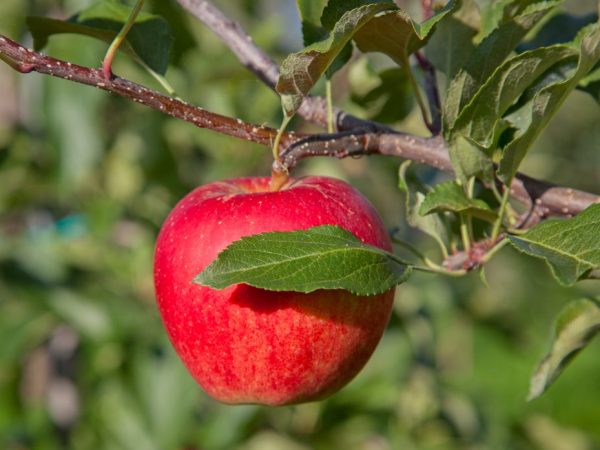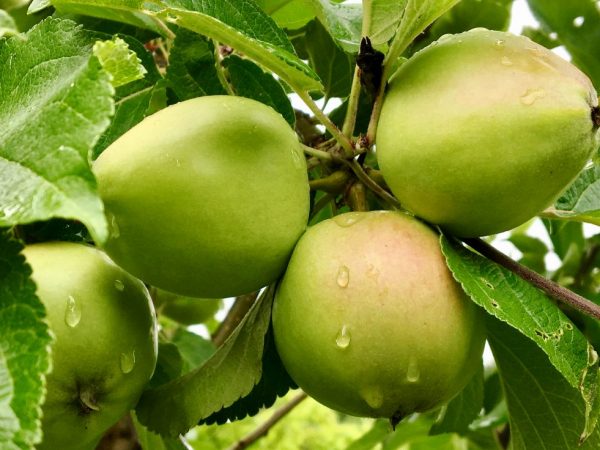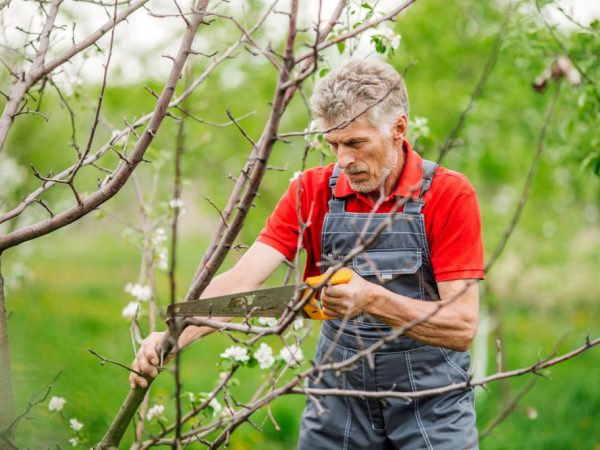Varietal characteristics of the Legend apple tree
The apple tree is one of the most common fruit trees in the world. Every year breeders develop new varieties that are resistant to diseases, with the best yield indicators. These include the Legend apple tree. It was bred in 1982 at the Moscow Institute of Horticulture by Professor V.V. Kichin.
- Characteristics of the variety
- Advantages and disadvantages
- Description of the tree and fruit
- Taste
- Yield
- Pollinators
- Drought and frost resistance
- Disease resistance
- Transportability
- Growing regions
- Using apples
- Landing
- Timing
- Technology
- Care
- Watering
- Top dressing
- Pruning and shaping the crown
- Preparing for winter
- Features of ripening and fruiting
- Harvesting and storage
- Subspecies and variants
- Gardeners reviews

Varietal characteristics of the Legend apple tree
Characteristics of the variety
Legend is one of the most promising varieties. It was obtained by crossing the Japanese Fuji (in first place in the list of apple trees) and Lingonberry (a bonsai with high yields).
The apple tree of this variety is out of competition for cultivation both in the farms of amateur gardeners and in industrial gardens.
Advantages and disadvantages
The tree has a lot of advantages:
- resistant to most diseases;
- excellent appearance and excellent taste of the fruit;
- a high level of adaptation to climatic conditions;
- good winter hardiness;
- undemanding to care.
At the same time, the species does not have significant drawbacks, because the breeders took into account the negative qualities of the parental varieties. But there is a small minus - the short (up to 15 years) life span of the apple tree.
Description of the tree and fruit
Compact columnar tree no more than 2.5-3 m high. The crown is dense, round, small. The main branches are small, compactly placed along the trunk. Leaves are medium in size, oval, silky, matte, dark green in color.
The apples are large, weight - 150-200 g. In shape, they resemble a truncated cone. Mostly fruits are of the same size and shape. The peel is firm, glossy, intense red with short dark red stripes. The pulp is juicy, with a granular structure, yellow with a greenish tinge.
Taste
The apples are very sweet, like caramel candies. They are juicy with a delicate, pleasant aroma. Dessert taste with a high score of 4.5 points.
Yield
With standard care, up to 100 kg of equally large commercial apples are harvested from the tree. If you pay more attention to the tree, the yield doubles. A fast-growing variety, apples ripen in the second year after planting.
Pollinators
A self-infertile hybrid, any varieties of autumn and winter apple trees can be used as pollinators.
Drought and frost resistance
The tree of this variety tolerates frosty winters well. Drought resistance is average, with regular abundant watering it will endure the heat without loss for the harvest.
Disease resistance

Good care will keep the tree from disease
The legend is practically not susceptible to the main diseases of apple trees and is resistant to pests. But in the absence of proper care or the presence of infected trees in the garden, she may become ill.
There are cases of diseases of trees with powdery mildew, bitter pitting, scab. In such cases, it is necessary to conduct a thorough examination of the trees, cut down the affected branches, treat the sections with a lime solution.
After harvesting, you need to spray the crown with a 3-5% solution of copper sulfate (use the product according to the instructions).
To avoid the invasion of pests, the most dangerous of which is the moth, it is recommended to treat the apple trees with the preparations Fitoverm, Accord, Alfatsin (a description of the recipe for the solution and application can be found in the instructions).
It is advisable to spray trees during the period of a mass invasion of caterpillars with the preparation "Lepidocide".
If the summer is wet, the trees can get scab, in this case fungicides are used: Bordeaux liquid, "Fitolavin", "Nitrofen".
Preventive measures should be taken:
- after finishing harvesting, carefully destroy plant residues;
- forming a crown, cut off diseased branches;
- treat mechanical damage with lime mortar.
Transportability
Thanks to its thin but dense peel, the Legend apple variety has excellent keeping quality (5-6 months) and transportability. The fruits have excellent commercial properties.
Growing regions
Due to the excellent adaptability of the variety to different climatic conditions, it can be grown in any region.
Using apples
The maximum amount of vitamins enters the body if apples are eaten fresh, but they are also suitable for all types of processing, including drying and canning.
Landing
For the successful cultivation of the Legend apple tree, you need to choose a good planting material. It is necessary to choose seedlings with a well-developed root system, intact bark, smooth trunk, and no leaves.
Timing
Planting should be done in autumn (September - October) or spring (mid April). In the second case, the tree manages to adapt and tolerates harsh winters more easily.
Technology
The landing pit is prepared 3-4 weeks before disembarkation. Its depth and width depend on the length of the seedling - the roots should be well positioned, and the root collar should protrude 6-7 cm above the ground level. A peg 50-100 cm high is driven into the hole.
A mixture of humus, peat, soil is poured into the hole in equal proportions. After that, a seedling is placed in the center of the pit, the roots are leveled, and the tree is tied to a peg. Then they cover it with earth and tamp it.
Pour 2-3 buckets of water on top. To retain moisture, it is recommended to mulch the soil with soil from the same area.
Care

It is necessary to form the crown of the tree
In order for the tree to grow and develop well, delighting the gardener with a rich harvest, it is necessary to follow some rules for caring for the crop.
Watering
Saplings need more frequent watering - 20 liters of water once a week, adult trees - 40 liters twice a month. If the summer is very hot, the watering rate should be increased. During fruiting, apple trees also need more liquid.
Top dressing
In the first year, the Legend apple tree is fed with urea or nitrate in liquid form three times during the season. In the second year, seedlings are fed with nitrogen fertilizers in the spring, and phosphorus-potassium fertilizers in summer and autumn.
Mineral fertilizers are applied under adult apple trees during flowering. After picking apples, a superphosphate solution is poured under the trees (40-50 g of substance per 10 l of water).
Pruning and shaping the crown
Crown formation begins in the first year after planting - you need to cut off a third of the shoots. In two-year-old trees, the crown is formed in such a way that, as a result, the branches are arranged in 3 tiers.
In subsequent years, pruning is aimed at preserving the center conductor. It must be remembered that no more than a quarter of the branches should be removed at a time.
Preparing for winter
After harvesting, they move on to preparing trees for wintering, for which the following is necessary:
- remove mulch from the tree trunk circle;
- remove the dead layer of bark and whitewash the tree with a solution of lime (mix clay, lime and vitriol in equal proportions with water);
- dig up the soil;
- apply phosphorus-potassium fertilizers (mix 350 g each and scatter in the trunk circle) to strengthen the root system.
It is important for wintering that a little watering is carried out before the start of the harvest.
To protect against hares, the apple tree stem is covered with roofing material or special material. Spruce tree is laid out near the trunk to keep snow.
Features of ripening and fruiting
The legend is a fast-growing crop, apples are harvested from two-year-old trees. From a five-year-old tree, you can get from 100 to 150 kg of apples.
According to the description, the crop belongs to the late autumn varieties. Apples begin to ripen in mid-September, with a full harvest in October.
Harvesting and storage
Harvesting is recommended in the afternoon in warm, dry weather. The apples are picked first from the south side, where they usually ripen earlier. After a couple of days, the collection of "northern" fruits begins.
The first to take the apples from the lower branches of the tree, moving towards the top. For better preservation, the stalks are not cut off. Damaged fruit should be set aside immediately. Handling apples carefully during harvest increases their shelf life.
Subspecies and variants
Apple variety Legend is grown on dwarf and columnar rootstocks. An adult tree on a dwarf rootstock is more compact and begins to bear fruit earlier.
The columnar apple tree is used in industrial horticulture. It takes up a minimum of area, but it is difficult to correctly form its crown.
Gardeners reviews
The Legend variety always pleases with a good harvest, requiring a minimum of care from the gardener. This is a great option for both professionals and beginners.
Gardeners love the apple tree for its excellent winter hardiness, delicious fruits and the fact that high-quality workpieces can be prepared from it. According to gardeners who grow this culture on their plots, this tree deserves the highest praise.

